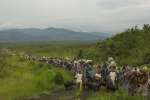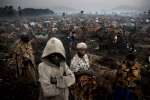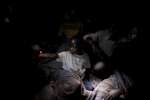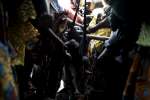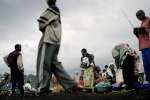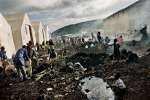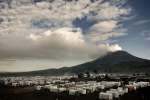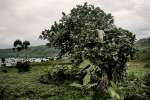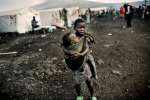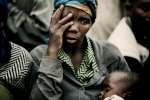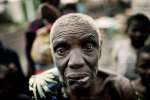- Text size
 |
|  |
|  |
| 
- Français
Six years on, Congolese refugees who fled LRA return home from CAR
News Stories, 3 August 2015
BANGUI, Aug 3 (UNHCR) – More than 600 Congolese refugees who fled into Central African Republic (CAR) six years ago to escape attacks from the Lord's Resistance Army (LRA) returned to their country on Monday (August 3) in an airlift organized by the UN refugee agency.
UNHCR said a first group of 39 Congolese refugees boarded a Dash-8 aircraft in Zemio, south-east CAR and flew to Ango in a remote area of Orientale province in northern Democratic Republic of Congo (DRC) in the first stage of a planned three-week repatriation exercise.
"Over the next three weeks, UNHCR plans to repatriate a total of 628 refugees on 12 chartered flights, including the one on Monday. The numbers could change," the agency said in a press release.
UNHCR said that all of the returnees had said they wished to leave UNHCR-run Zemio and return to their homes in the Ango area because of concerns about the volatile security situation now prevailing in CAR.
UNHCR has worked with the governments of CAR and DRC to facilitate the voluntary repatriation to Ango. The LRA still has a presence in the area, but the governments believe the situation is stable enough to allow for return.
"The refugees were fully informed about the security situation in return areas before they made a final decision to go back," the press release noted.
Between 2008 and 2009, around 5,000 Congolese fled LRA attacks and atrocities in the Ango and Obo border areas into CAR. The feared Ugandan rebel group robbed villagers, looted property, torched homes, kidnapped people, raped women and girls and used the young as child soldiers and sex slaves.
Most found shelter in Zemio, a camp run by UNHCR and now hosting 3,499 refugees, including those now going home in the airlift programme. Since the latest wave of instability began rocking CAR in 2012, many Congolese refugees have made their way home from Zemio and other parts of CAR.
UNHCR, meanwhile, is looking for durable solutions for those opting not to return to the DRC. Funding shortages could affect the level of aid at Zemio, which is in a volatile area and difficult to access.
The lack of roads makes overland repatriation impossible and the airstrip at Ango has been rehabilitated and extended.
On arrival, each returnee will be given US$60 to cover the cost of travel to their villages along dirt tracks on motorbikes, bicycles or foot. UNHCR is also providing a repatriation grant of US$150 per adult and US$100 per child. The World Food Programme will give out cash vouchers for food.
The refugees will be returning to an area where the weakened LRA has launched sporadic attacks in past months. The last reported incident was in late July. But the government in Kinshasa has reviewed the security situation and given the green light for the return operation.
The LRA appeared in Uganda in 1986, established its first base in Sudan in 1993, and spread to the DRC in 2005, before moving further north into CAR in 2009.
















